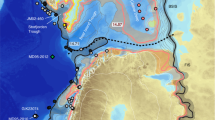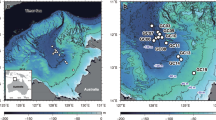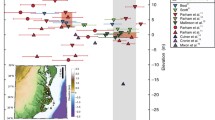Abstract
Re-evaluation of the post-glacial sea level derived from the Barbados coral-reef borings suggests slightly revised depth ranges and timing of melt-water pulses MWP-1A (96–76m, 14.3–14.0ka cal BP) and IB (58–45m, 11.5–11.2ka cal BP), respectively. Ages of non-reef sea-level indicators from the Sunda Shelf, the East China Sea and Yellow Sea for these two intervals are unreliable because of the well-documented radiocarbon (14C) plateau, but their vertical clustering corresponds closely with MWP-1A and IB depth ranges. Close correlation of the revised sea-level curve with Greenland ice-core data suggests that the 14C plateau may be related to oceanographic-atmospheric changes due to rapid sea-level rise, fresh-water input, and impaired ocean circulation. MWP-1A appears to have occurred at the end of Bølling Warm Transition, suggesting that the rapid sea-level rise may have resulted from lateral heat transport from low to high-latitude regions and subsequent abrupt ice-sheet collapses in both North America-Europe and Antarctica. An around 70 mm a−1 transgression during MWP-1A may have increased freshwater discharge to the North Atlantic by as much as an order of magnitude, thereby disturbing thermohaline circulation and initiating the Older Dry as global cooling.
Similar content being viewed by others
Explore related subjects
Discover the latest articles and news from researchers in related subjects, suggested using machine learning.References
Bard, E., B. Hamelin, and R.G. Fairbanks, 1990. U-Th ages obtained by mass spectrometry in corals from Barbados: sea level during the past 130 000 years. Nature, 346: 456–458.
Bard, E., M. Arnold, M. Mangerud, M. Paterne, L. Labeyrie, et al., 1994. The North Atlantic atmospheresea surface 14C gradient during the Younger Dryas climatic event. Earth and Planetary Science Leters, 126: 275–287.
Bard, E., B. Hamelin, M. Arnold, L. Montaggioni, G. Cabioch, et al, 1996. Deglacial sea-level record from Tahiti corals and the timing of global meltwater discharge. Nature, 382: 241–244.
Bard, E., G. Cabioch, M. Arnold, B. Hamelin, and N. Tisnerat-Laborde, 1998. Radiocarbon calibration by means of mass spectrometric 230TH/234U and 14C ages of corals: An updated database including samples from Barbados, Mururoa and Tahiti. Radiocarbon, 40: 1085–1092.
Broecker, W.S., J.P. Kennett, B.P. Flower, J.T. Teller, S. Trumboe, et al, 1989. Routing of meltwater from the Laurentide Ice Sheet during the Younger Dryas cold episode. Nature, 341: 318–321.
Burr, G.S., R.L. Edwards, G. Cabioch, T. Correge, D. J. Donahue, et al., 1998. A high-resolution radiocarbon calibration between 11 700 and 12 400 calendar years BP derived from 230Th ages of corals from Espiritu Santo Island, Vanuatu. Radiocarbon, 40: 1093–1105.
Chappell, J., and H. Polach, 1991. Post-glacial sea-level rise from a coral record at Huon Peninsula, Papua New Guinea. Nature, 349: 147–149.
Clark, P.U., S.J. Johnsen, W. Huaxiao, R.B. Alley, L. D. Keigwin, et al, 1996. Origin of the first global meltwater pulse following the Last Glacial Maximum. Paleoceanography, 11: 563–577.
Clark, P. U., J. X. Mitrovica, G. A. Milne, and M. E. Tamisiea, 2002. Sea-level fingerprinting as a direct test for the source of global meltwater pulse IA. Science, 295: 2438–2441.
Dansgaard, W., J.W.C. White, and S.J. Johnsen, 1989. The abrupt termination of the Younger Dryas climate event. Nature, 339: 532–534.
Edwards, R. L., J.W. Beck, G.S. Burr, D.J. Donahue, J. M. A. Chappell, et al., 1993. A large drop in atmospheric 14C/12C and reduced melting in the Younger Dryas, documented with 230Th ages of corals. Science, 260: 962–968.
Fairbanks, R. G., 1989. A 17000 year glacio-eustatic sea level record: influence of glacial melting rates on the Younger Dryas event and deep-ocean circulation. Nature, 342: 637–642.
Ganopolski, A., and S. Rahmstorf, 2001. Rapid changes of glacial climate simulated in a coupled climate model. Nature, 409: 153–158.
Guilderson, T. P., L. Burckle, S. Hemming, and W. R. Peltier, 2000. Late pleistocene sea level variations derived from the Argentine Shelf. Geochemistry, Geophysics, Geosystems, 1: 2000GC000098.
Hanebuth, T., K. Stattegger, and P. M. Grootes, 2000. Rapid flooding of the Sunda Shelf: A late-glacial sea-level record. Science, 288: 1033–1035.
Hori, K., Y. Saito, Q. Zhao, X.R. Xheng, P.X. Wang, et al, 2001. Sedimentary facies of the tide-dominated paleo-Changjiang (Yangtze) estuary during the last transgression. Marine Geology, 177: 331–351.
Hughen, K.A., J. Southon, L.C. Peterson, R. Alley, D. M. Sigman, et al, 1998. Deglacial changes in ocean circulation from an extended radiocarbon calibration. Nature, 391: 65–68.
Hughen, K. A., J. R. Southon, S. J. Lehman, and J. T. Overpeck, 2000. Synchronous radiocarbon and climate shifts during the last deglaciation. Science, 290: 1951–1954.
Keigwin, L. D., G. A. Jones, S. J. Lehman, and E. A. Boyle, 1991. Deglacial meltwater discharge, North Atlantic deep circulation, and abrupt climate change. Journal of Geophysical Research, 96: 16811–816826.
Keigwin, L.D., and M-A. Schlegel, 2002. Ocean ventilation and sedimentation since the glacial maximum at 3 km in the western North Atlantic. Geochemistry, Geophysics Geosystems, 3: 1029/2001GC000283.
Kienast, M., T. J. J. Hanebuth, C. Pelejero, and S. Steinke, 2003. Synchroneity of meltwater pulse 1A and the Bølling warming: New evidence from the Bølling South China Sea. Geology, 31: 67–70.
Kim, J. M., and M. Kucera, 2000. Benthic foraminifer record of environmental changes in the Yellow Sea (Huanghe) during the last 15 000 years. Quaternary Science Reviews, 19: 1067–1085.
Kitagawa, H., and J. van der Plicht, 1998. Atmospheric radiocarbon calibration to 45 000 yr B.P.: Late glacial fluctuations and cosmogenic isotope production. Science, 279: 1187–1190.
Lai, D., and B. Peters, 1962. In Progress in Elementary Particle and Cosmic Ray Physics. J. G. Wilson, and S. A. Wouthusen, Eds., North-Holland, Amsterdam, 1–74.
Lambeck, K., Y. Yokoyama, A. Purcell, and P. Johnston, 2002. Reply to the comment by W. R. Peltier. Quaternary Science Reviews, 21: 415–418.
Lighty, R.G., I.G. Macintyre, and R. Stuckenrath, 1982. Acropora Palmata reef framework: a reliable indicator of sea level in the Western Atlantic for the past 10 000 years. Coral Reefs, 1: 125–130.
Liu, M.H., Wu, S.Y., and Wang, Y.J., 1987. Late Quaternary Sediments of the Yellow Sea. China Ocean Press, Beijing, 433 pp.
Liu, J., Li, S.Q., Wang, S.J., Yang, Z.G., and Ge, Z. S., 1997. A rock-magnetic study of the last deglacial to Holocene sedimentary sequence in the YSDP105 core in the northeast shelf of the South Yellow Sea. Marine Geology and Quaternary Geology, 17(4): 13–24.
Liu, J.P., 2001. Post-glacial Sedimentation in a River-dominated Epicontinental Shelf: The Yellow Sea Example. Ph.D. Dissertation. The College of William and Mary, USA.
Liu, J.P., J.D. Milliman, S. Gao, and P. Cheng, 2004. Holocene development of the Yellow River’s subaqueous delta, North Yellow Sea. Marine Geology, 209(1–4): 45–67.
Johnsen, S. J., C. U. Hammer, U. Andersen, K. K. Andersen, C.S. Hvidberg, et al., 1997. The 18O record along the Greenland Ice Core Project deep ice core and the problem of possible Eemian climatic instability. Journal of Geophysical Research, 102: 26397–26410.
Monnin, E., B. Stauffer, T. F. Stacker, D. Raynaud, J. M. Barnola, et al., 2001. Atmospheric CO2 concentrations over the last glacial termination. Science, 291: 112–114.
Muscheler, R., J. Beer, G. Wagner, and R. C. Finkel, 2000. Changes in deep-water formation during the Younger Dryas event inferred from 10Be and 14C records. Nature, 408: 567–570.
Neumann, A.C., and I.G. Macintyre, 1985. Reef response to sea level rise: keep up, catch up or give up. Proc. 5th International Coral Reef Congress, Tahiti.
Peltier, W. R., 1998. Postglacial variations in the level of the sea: Implications for climate dynamics and solid-earth geophysics. Reviews of Geophysics, 36: 603–689.
Peltier, W.R., 2002. Comments on the paper of Yokoyama et al. (2000), entitled ‘Timing of the Last Glacial Maximum from observed sea level minima’. Quaternary Science Reviews, 21: 409–414.
Peltier, W. R., and R. Drummond, 2002. A ‘broad-shelf effect’ upon postglacial relative sea level history. Geophysical Research Letters, 29: 10–14.
Severinghaus, J.P., and E.J. Brook, 1999. Abrupt climate change at the end of the last glacial period inferred from trapped air in polar ice. Science, 286: 930–934.
Smith, H.J., B. Deck, H. Fischer, M. Wahlen, and D. Mastroianni, 1999. Dual modes of the carbon cycle since the Last Glacial Maximum. Nature, 400: 248–250.
Southon, J., 2002. A first step to reconciling the GRIP and GISP2 ice-core chronologies, 0-14500 yr B.P. Quaternary Research, 57: 32–37.
Steig, E.J., P.M. Grootes, P.A. Mayewski, M.S. Twickler, S.I. Whitlows, et al., 2000. Wisonsinan and Holocence climate history from an ice core at Taylor Dome, western Ross embayment, Antarctica. Geografiska Annaler, Series A:. Physical Geography, 82: 213–232.
Suk, B.C., T. Nakamura, N. Nakai, and A. Taira, 1990. Radio-carbon age determination by Tandem Accelerator Mass Spectrometry Technique and its application to the Korean sea. The Korean Journal of Quaternary Research, 4(1): 27–40.
Weaver, A. J., O. A. Saenko, P. U. Clark, and J. X. Mitrovica, 2003. Meltwater pulse 1A from Antarctica as a trigger of the Bølling-Allerod Warm interval. Science, 299: 1709–1713.
Author information
Authors and Affiliations
Corresponding author
Rights and permissions
About this article
Cite this article
Liu, J.P., Milliman, J.D. Reconsidering melt-water pulses 1A and 1B: Global impacts of rapid sea-level rise. J Ocean Univ. China 3, 183–190 (2004). https://doi.org/10.1007/s11802-004-0033-8
Received:
Accepted:
Issue Date:
DOI: https://doi.org/10.1007/s11802-004-0033-8




